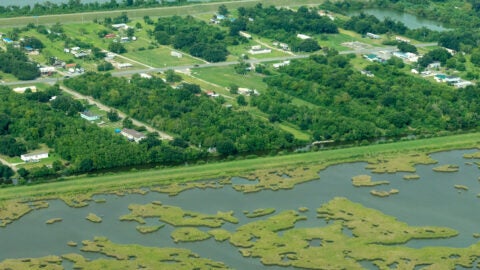
New modeling shows the power and potential of cap-and-invest in Washington state
Washington state’s cap-and-invest program, created in the 2021 Climate Commitment Act (CCA), is nearing the end of its second year and has already raised over $2 billion for communities by putting a price on pollution.
The program is a win-win for climate action and for communities: It creates a powerful economic incentive for companies across the state to lower their emissions, while generating investments for Washington communities in the process. There are already many projects underway across all 39 counties in the state, putting that auction revenue to use. Some of the benefits that people in Washington are seeing include:
- More access to cleaner public transit including free ferry, bus, and other transit rides for youth.
- Cleaner air for children in and around schools with upgrades to zero-emissions school buses and new, efficient HVAC systems.
- Lower energy bills for low-income households and small businesses who receive support for replacing old gas furnaces with modern and efficient electric alternatives.
But the scale of this program enables it to deliver much more for Washington’s communities and economy in the long run. Just how much more? Thanks to new, in-depth modeling from Greenline Insights, supported by EDF, we now have a clearer picture of the transformative impact this program could have.
The CCA is game-changing for Washington’s economy and climate
Released in September, the new modeling reveals significant potential for the CCA to drive not only environmental progress but also substantial economic gains. The numbers are impressive: the study projects that over an 8-year period, CCA investments could create more than 45,000 new jobs and generate $9.1 billion in economic output. This results in a net return on investment of $3.9 billion for the state.
But that’s just the beginning. The CCA’s structure allows Washington to leverage additional sources of funding — federal, state, local, and private capital — making it a magnet for even greater investment. In fact, the modeling estimates that thanks to the CCA, Washington could attract over $29 billion in total investments over the next 8 years, spurring the creation of up to 263,000 jobs and generating $51 billion in economic output. Each dollar invested through the CCA is expected to generate over $13 in economic returns, making it a powerful economic engine for the state.
“Simply put, the Climate Commitment Act is a powerful economic engine,” said Jonah Kurman-Faber, an author of the study. “Our study shows that when Washington invests in clean air, transportation, efficient homes, and other CCA programs, what follows is explosive job growth, economic development, and new federal and private investments across the state.”
The report also breaks down how different sectors of the economy stand to benefit, from clean energy to construction, infrastructure, and beyond. Work related to efficient homes and buildings, for example (such as construction trades, material movers, and retail sales) is projected to see 6,900 new jobs over the next 8 years thanks to the CCA, creating $1.6 billion in economic activity. 6,000 new jobs are projected in the ferries and maritime sector, including metal and plastic workers, manufacturing operations, maintenance, and assemblers. Explore more of the sector-specific expected benefits of the CCA by reading through the one-pagers on several economic areas here.
Investments at Risk
However, all of these investments from cap-and-invest, along with the jobs and economic activity this modeling shows would be created, could be lost depending on the outcome of I-2117, a ballot measure that seeks to repeal the CCA. This initiative qualified for the ballot after hedge-fund executive Brian Heywood spent millions of dollars to personally bankroll an effort to get qualifying signatures on a slate of issues, including the cap-and-invest repeal. If I-2117 passes, the cap-and-invest program would be fully repealed, immediately putting an end to the economic activity the policy is poised to generate, as well as the cleaner air from reduced emissions.
Key takeaways
So what’s the big takeaway? Investing in climate action and clean energy doesn’t just protect the planet — it pays off economically, and on a massive scale. This is the power of cap-and-invest: by pairing a binding, declining cap on emissions along with a framework to collect revenue from polluters and invest it back into the state, we can jump-start a clean energy economy, make communities more resilient to climate impacts, and reduce climate-warming pollution all at the same time. [Want to learn more about how cap-and-invest works? Check out our resources here.]
As more states consider cap-and-invest programs as a way to reduce climate pollution and kickstart their clean energy economies, this research underscores the “win-win” potential of cap-and-invest programs. Pairing a binding emissions limit with a mechanism for local clean energy investments enables climate action that can create jobs and boost economic output, while reducing emissions and creating a healthier planet for future generations.




















